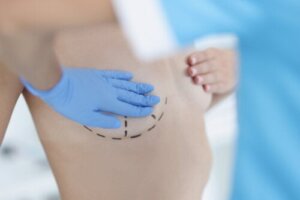Mastopexy: The Benefits and Risks of Breast Augmentation


Reviewed and approved by the nurse Leidy Mora Molina
Mastopexy is a surgery performed for aesthetic purposes to lift or elevate the breasts and give them symmetry when they are unequal. It can be done with decreased volume or increased by implants.
The procedure is performed in an operating room and requires general anesthesia. This technique seeks to give a more youthful appearance, helping the person to feel better about their appearance.
What is a mastopexy and what is it done for?
There are several factors that cause the breasts to sag. These range from pregnancy, age, and weight changes, to wearing the wrong bra, smoking, poor posture, and not exercising. Likewise, the larger the initial size, the more noticeable the sagging may be.
To correct this problem there are different alternatives. Some are natural and include exercises to reaffirm the bust, creams, consumption of infusions, and posture improvement.
On the other hand, there are aesthetic procedures. These include:
- Mesotherapy
- Radiofrequency
- Hyaluronic acid
- Polycaprolactone
- Aesthetic surgeries, among which is the mastopexy, also known as the breast lift. Its purpose is to put the breasts back in place, when they have fallen, in what is defined as a breast ptosis.
This surgical technique may include a reduction in cases where the breast is too large. It may also include augmentation with implants when the breast is small. The areola and nipple can also be repositioned.
Mastopexy is intended to give the breasts a rejuvenated appearance so that they look more symmetrical. This, in turn, helps the person feel more confident and boosts self-esteem.
We think you may also find this article interesting: Chemotherapy for Breast Cancer: Types and Stages
Preparation for surgery
Depending on the person’s age and some risk factors, the surgeon may recommend a mammogram or other imaging tests in certain cases. In turn, the patient should inform if she is pregnant, what medications she takes, and even what natural supplements she uses.
The physician may indicate that the use of anticoagulants, such as warfarin, and antiplatelet agents, such as aspirin, be suspended.
Other recommendations beforehand are the following:
- The patient should fast before surgery. She will be informed how many hours beforehand she should stop eating and drinking.
- She should also wear loose clothing that is easy to take off and put on. Above all, they should have buttons or zippers on the front.
- It’s necessary to go with a companion, since it will not be possible to drive afterward.

What is the procedure like?
As mentioned, mastopexy is performed under general anesthesia, usually with intravenous sedation. Also, it must be performed in an operating room, with adequate sanitary conditions, and by professionals with training and experience in the management of this technique.
The surgeon makes between one and three cuts, according to the size, shape, degree of flaccidity, the position of the areola, excess skin, or when – in addition to the lift – a breast reduction is performed.
There are several types of incisions that can be practiced:
- Anchoring incision: This is made around the areola: from the areola vertically down to the breast crease, and then horizontally, along the breast crease.
- A Keyhole incision: This is made around the areola and then downward in a vertical downward line.
- A periareolar incision: As the name implies, this is done around the areola.
- A half-moon incision: This is done along the upper half of the areola.
However, according to research on the subject, currently, in most mastopexies, parenchymal manipulation is performed in order to ensure longer-lasting results. In turn, depending on the need, additional skin or breast tissue will be removed, repositioning the nipple and areola or placing implants, if such is the case.
On the other hand, a 2015 study proposes a circumlocutional technique, in which base circumference reduction, glandular rotation, and repositioning are combined. This is claimed to increase the anterior projection and better define the lateral border of the sinus.
To culminate, a drain may be left in some cases. This is then sutured and a gauze dressing is placed. The overall duration of the procedure is estimated to be between two and four hours. Recovery is short. Most likely, the patient can be discharged from the hospital on the same day.
You may also be interested in reading this article: Breast and Nipple Changes: When Is It a Concern?
Care after the surgery
One week after the procedure, the person can return to their activities as normal, as long as they comply with rest and the following care:
- Wear a special bra for the time indicated by the surgeon.
- Avoid sudden movements or heavy lifting.
- Suspend physical activity for a week.
Do not apply ice unless your doctor tells you to do so. To mitigate the pain, the surgeon will recommend certain painkillers on demand.
On the other hand, if the patient is a smoker, it’s recommended to avoid the habit. This can affect the microcirculation and, consequently, the healing.
The results and benefits
With mastopexy, not only are the breasts lifted, but the shape, symmetry, and projection of the breasts can be improved. The goal is usually to make you feel better about your appearance.
Although the surgeon makes the cuts so that they are not so noticeable (following, for example, the line of the areola), the scars are visible for a while, up to a year. Then they fade a little, but not completely.
Of course, they will not be noticeable with clothing; even if necklines are worn. If desired, you can apply some products, such as natural creams to reduce the scars, as long as you have your doctor’s authorization.
The results of mastopexy usually remain in the long term. It all depends on several factors, such as diet, overweight, pregnancy, breastfeeding, and hormonal action.
However, there may also be some unsatisfactory results, when implants are placed in a retromuscular position. The most frequently reported in the research are: asymmetries, displacements, and double breast contour.
Also, it’s possible that the breasts may fall again with age. However, if the person desires it, it is possible to have another breast lift procedure or a change of implants.

Who is a mastopexy recommended for?
A mastopexy may be an option for women in whom weight gain or loss, aging, or pregnancy has left sequelae in their breasts. It’s also an alternative when the surgeon believes that implants alone will not achieve sufficient lift.
It’s also possible to combine both procedures.
However, it’s not recommended if you are planning to lose weight, if you’re pregnant, or if you plan to become pregnant. Nor is it possible if you are still breastfeeding. In these cases, it’s best to wait.
Possible risks and complications
As with any surgery, with a mastopexy there are some risks related to anesthesia, possible infections, bleeding from wounds, swelling, and thick scars. Additionally, particular complications may occur:
- Difficulty breastfeeding
- A loss of sensation in the nipples
- Asymmetry of the breasts (a larger or differently shaped breast) or nipples
In general, such problems are rare. However, complications due to the use of implants, such as encapsulation, displacement, or rupture should also be added to these.
Finally, there are also emotional risks, derived from the expectations of the person from the aesthetic point of view. These could be disappointed if the breasts do not look as expected.
Some of these risks can be minimized if the surgery is performed by a specialist, experienced in handling the technique. They may also be minimized if it’s performed under adequate conditions – that is, in a properly equipped operating room.
All cited sources were thoroughly reviewed by our team to ensure their quality, reliability, currency, and validity. The bibliography of this article was considered reliable and of academic or scientific accuracy.
- Berrocal-Revueltas M. Mastopexia con prótesis: técnica triplanar con colgajo en cola de pez para mamas con pobre calidad de cobertura. Cir. plást. iberolatinoam. 2013; 39(4): 348-359.
- Cáceres Miotto G, Eaves F. The circumrotational technique for mastopexy. Aesthetic Surgery Journal. 2015; 35(7): 796–809.
- Cervilla-Lozano J. Lipoestructura mamaria y ptosis. Cir. plást. iberolatinoam. 2014; 40(4): 369-376.
- Expósito-Jalturin A, Escobar-Vega H, Carbón A, Paredes-Javier W, Cuastumal-Figueroa D. Tratamiento de la ptosis mamaria con mastopexia periareolar más endoprótesis. Acta Médica. 2022; 23(3). Disponible en: https://revactamedica.sld.cu/index.php/act/article/view/330
- Galli R, Marcelo T, Plot E. Mastectomia bilateral de limpieza: complicación a distancia de los implantes mamarios: revisión literaria acerca de un caso clínico. Cir. Parag. 2010; 34(1): 33-40.
- Navarro R, Torreblanca L, Enríquez A. Mastopexia de aumento, técnica de quinta generación. Cir. plást. iberolatinoam. 2008; 34(2): 89-100
- Sandoval M, Droppelmann K. Anticoagulantes y antiplaquetarios en cirugía dermatológica Rev. chil. dermatol, 2010; 26(3): 328-332.
- Qureshi A, Myckatyn T, Tenenbaum M. Mastopexy and Mastopexy-Augmentation. Aesthet Surg J. 2018; 38(4): 374-384.
This text is provided for informational purposes only and does not replace consultation with a professional. If in doubt, consult your specialist.








